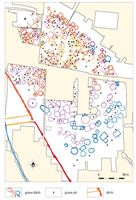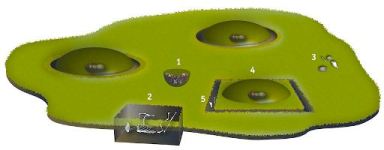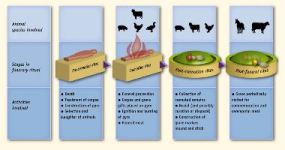
Figure 30: Excavation plan of the cremation cemetery in Tiel-Passewaaij. The colours of the grave ditches refer to the phases they date to. Orange: AD 60-90; Red: AD 90-150; Purple: AD 150-200; Blue: AD 200-260 (Aarts and Heeren 2007).
The cremation cemetery of Tiel-Passewaaij is the largest Roman cemetery excavated in the Netherlands that was used by a rural population (Fig. 30). The cemetery was in use between AD 60 and 270 and contained almost 500 graves. The cemetery was used by the two excavated settlements, and possibly by a third (Aarts and Heeren 2007, 74). It is located between the settlements Oude Tielseweg and Passewaaijse Hogeweg.

Figure 30: Excavation plan of the cremation cemetery in Tiel-Passewaaij. The colours of the grave ditches refer to the phases they date to. Orange: AD 60-90; Red: AD 90-150; Purple: AD 150-200; Blue: AD 200-260 (Aarts and Heeren 2007).
The location of the cemetery on the streamridges had consequences for the total area of arable land that was available. Thus, the space for the dead as well as that for the living competed with space for farming. Obviously, it was important to local people that graves were not disturbed by flooding.
After the cremation of an individual on a funeral pyre, the remains were gathered with or without charcoal remains from the pyre, and buried in a pit (Fig. 31). A circular or rectangular ditch was dug around the pit, and the earth piled on top of the grave to form a low mound.

Figure 31: A reconstruction of the different contexts in the cemetery. 1: cremation grave; 2: animal burial; 3: original ground surface; 4: ceremonial pit; 5: grave ditch. Illustration Bert Brouwenstijn, ACVU.
Animals played a role in several different stages of the funerary ritual (Fig. 32; Groot 2008a, 159-88). This is reflected by the location of finds of animal bones. Burned and some unburned remains were recovered from the burial pits. Tiel-Passewaaij is the first cemetery for which unburned animal remains were found in grave ditches. In earlier excavations, too much focus was placed on the grave contents, at the cost of excavating the ditches completely. Although other cemeteries have since revealed unburned bones from grave ditches, their numbers are insignificant. Two burials of complete animals – an adult male horse and a young calf – were also found in the cemetery of Tiel-Passewaaij.

Figure 32: Animals in funerary ritual in Tiel-Passewaaij: a reconstruction. Illustration Bert Brouwenstijn, ACVU.
On the basis of the analysis of the animal remains, the following reconstruction of the Batavian funerary ritual can be made. Meat portions were placed on the funeral pyre and burned with the deceased. When the cremated remains were selected for burial, no distinction was made between human and animal remains, and both were placed in the burial pit. Apart from the cremated remains, unburned meat portions were sometimes also placed in the burial pit. No finds were included in the grave mound. During later visits to the grave, the survivors brought parts of cattle and horse with them, and left these either on the grave mound or in the grave ditch. The erosion of the grave mounds has ensured the survival of the animal bones in grave ditches. The burial of a complete animal (horse or cow) was a rare event, and may have been associated with the burial of an important person.
While no botanical remains were recovered from the cemetery, it is likely that vegetable foods were both consumed and given to the deceased within the funerary ritual.
© Internet Archaeology/Author(s)
URL: http://intarch.ac.uk/journal/issue27/5/3.2.3.html
Last updated: Tue Nov 10 2009